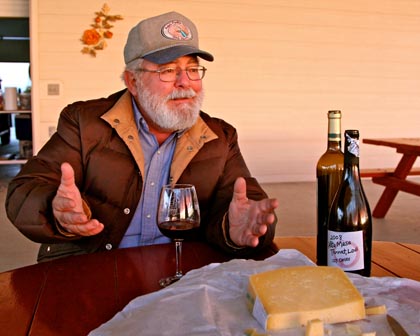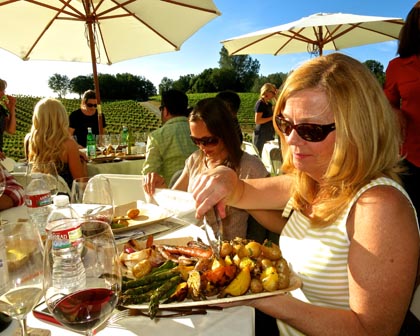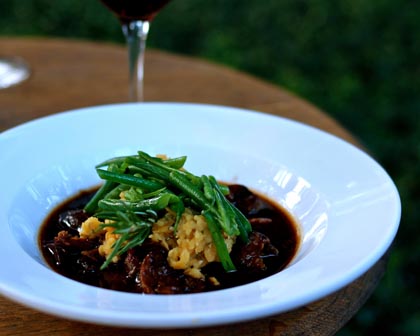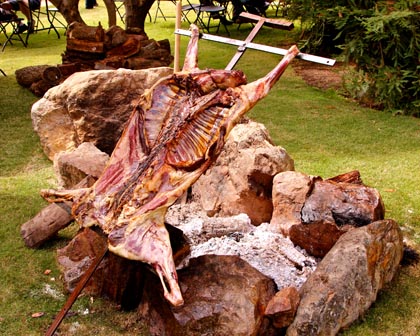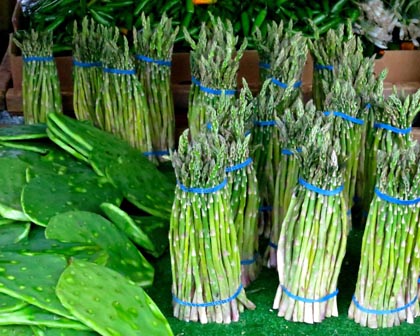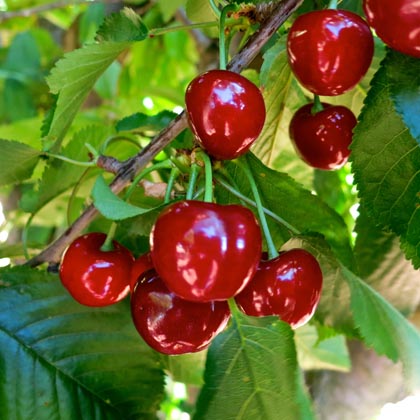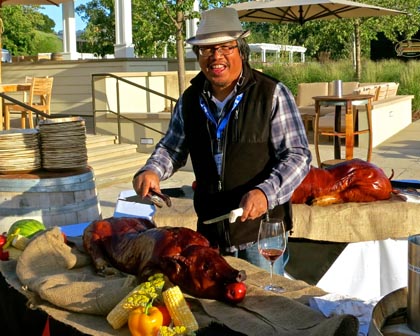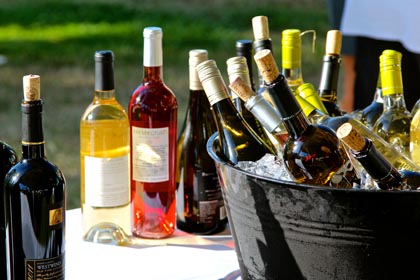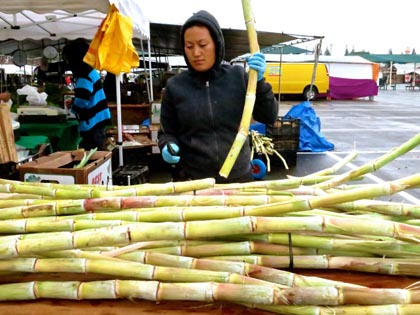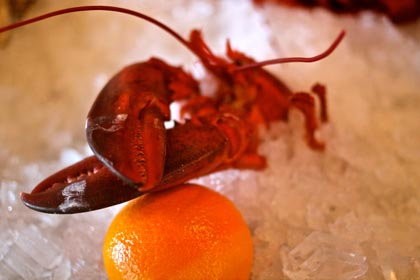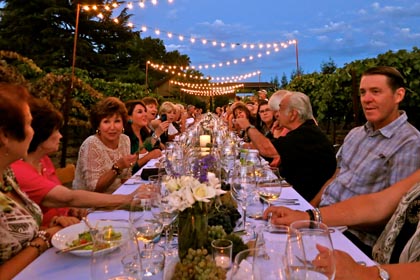Letters from Lodi
An insightful and objective look at viticulture and winemaking from the Lodi
Appellation and the growers and vintners behind these crafts. Told from the
perspective of multi-award winning wine journalist, Randy Caparoso.
The science behind common sense wine and food combinations
Common sense match: powerful reds with aged Portuguese cheese at Silvaspoons Vineyards.
Wine has often been called a combination of art and science; and in our culinary schools, cooking is accurately described as a "food science."
This does not mean that you have to be a brain surgeon to really understand food, or the way wines and foods go together. But it does help to have a basic understanding of the concepts, which we'll try to put together here…
Like semblance of fashion
One thing we all know: most of what we comprehend about wines and foods is instinctive—the result of tried-and-true experiences. No one has to explain why a filet of white fish or chicken tastes really good with a dry, lemony tart white wine, or that heavy duty Cabernet Sauvignon is a good idea with grilled, charred steak. This is just common sense, like knowing that a skirt looks stupid over a pair of jeans, or that your old man probably shouldn't mix a polka dot tie with a striped shirt and plaid sportcoat.
But here's where it gets tricky. If you follow the recipe from a popular cookbook, or go to a fancy-schmancy restaurant, you realize that steaks aren't always simply grilled or roasted these days. No, no: chefs as well as home cooks are often marinating beef in salty-sweet-spicy soy sauces, drenching them in sweet fruit or Port infused French sauces, plastering them with hot-vinegary barbecue dips, dousing them in lime and chili peppers, topping them with lemony couscous or tropical fruit salsas, and on and on.
At that point, is a big, hefty Cabernet Sauvignon still the perfect match? You could say yes; but common sense also tells you that there may be a number of other red wines that could taste even better with a fussed-over steak—a Zinfandel, a Petite Sirah, or even something less obvious like a red Grenache, Carignane, Teroldego or Pinotage. The choices in red wine, in other words, can be as varied as the ways to cook a steak, or the way to put clothes together… although it still doesn't make sense to mix polka dots, stripes and plaids.
Some combinations are better than others
So if you truly care about maximizing your wine and food experiences, at least a little semblance of scientific notions might be in order. Believe it or not, virtually everyone already approaches culinary matters with a scientific bent.
Take, for instance, a scoop of vanilla ice cream: does anyone eat vanilla ice cream by itself? Not really. What a lot of people think is great with vanilla is some hot chocolate syrup – something sweet like the ice cream, but adding a chocolate flavor served up at a different temperature… now we're talkin'. Then to really doll things up, we often add more contrasting, yet complimenting, flavors, like sliced bananas, nuts and cherries. Of course, we need whipped cream, which adds an airier texture to the combination, and a creamy taste all its own.
But not everything goes with vanilla ice cream. For instance, ketchup, scrambled eggs, anchovies, or tuna fish don't add very much. It's the same thing for Cabernet Sauvignon and a steak: these two things usually go great together, but not everything goes great with a steak, and not everything goes great with a glass of Cabernet Sauvignon. Sometimes sensations that are extremely contrasting—like a sweet-sour sauce on a steak with a dry, tannic Cabernet—will clash and crash, and are as bad an idea as polka dots, stripes and plaids.
Braised lamb shanks and Zinfandel at Harney Lane Winery.
Hence, the most basic premise, or science, behind how wines and foods go together: that not every kind of wine goes great with any kind of dish. Some combinations are simply better than others, and the reasons can be boiled down to these basic principles:
1st Principle: Wine is a food
In traditional European wine cultures, wine has always been considered a food group. Not so in the U.S.; but for our purposes, all food and wine matching is more easily understood when you start to think in terms of the taste components in wines—such as the tartness of acidity in white wines, or the mild bitterness of tannin in red wines—as being the same as ingredients in a dish.
Just like good cooking involves a balancing of ingredients and technique, good wine/food matching involves focusing on how specific components in wines interact and achieve some sense of balance and harmony with specific components in dishes.
But a cook can add too much salt or spice to a dish, the same way that a Cabernet Sauvignon can have too much tannin, oak or alcohol to taste ideal with a dish (extreme cases: trying to enjoy Cabernet Sauvignon with ice cream or scallop seviche). This is why you always need to apply this first principle: sensations are ideally balanced enough to compliment each other, the same way as when you’re cooking and balancing ingredients. Otherwise, it’s just not as good a combination.
Wood fired goat (served with Spanish varietals) at Bokisch Vineyards
2nd Principle: Five basic taste sensations
That is to say, what your taste buds perceive, whether you are tasting wine or food:
• Sweetness—Related to amount of residual sugar in both foods and wines.
• Sour/tartness—Degree of acidity in both foods and wines (more so in whites than in reds).
• Saltiness—Not a significant component in wine, but important in respect to how a wine relates to salty sensations in foods.
• Bitterness—Tasted in many foods, and in the tannin content of red wines (to a lesser degree in white wines often aged in oak, such as Chardonnay; or white wines made from thicker skin varieties, such as Verdelho or Gewürztraminer).
• Umami—The flattering, amino acid related sense of "deliciousness" found in many foods, and to a limited extent in wines (think of how Parmigiano cheese, which is high in amino acids, enhances a plate of spaghetti; or how umami-rich mushrooms or truffles suffuse and enrich many dishes).
Nopales and asparagus at Galt Market.
3rd Principle: Key tactile sensations
Like the hot/cold of chocolate syrup and ice cream, these are some key factors in many food/wine matches:
• Density, body or weight—The sense of light vs. heavy contributed by proteins, fats and/or carbs in foods, and primarily related to degree of alcohol and tannin content in wines (higher alcohol wines tend to be fuller bodied than lower alcohol wines, and full bodied red wines with lots of tannin tend to taste even heavier).
• Soft/crisp textures—Tactile contrasts you find in foods; and in wines, the sensations that you find to be smooth and easy vs. hard, sharp or angular.
• Spicy/hot—The feel of stinging heat when chiles, peppers or horseradishes are used in foods; which are not felt as a tactile sensation in wines, but are often suggested in aromas and flavors (the "spice" notes you find in wines, such as peppery Zinfandels and Petite Sirahs, bell peppery Cabernet Sauvignon, or peppery/lychee-like Gewürztraminers).
Lodi grown bing cherries.
4th Principle: Flavor is aroma related
Without the sense of smell, neither foods nor wines have "flavor." This why when you have a bad cold, everything tastes like paper—no smell, no flavor!
In terms of food: the taste and tactile sensations in an apple, a pineapple, and an onion are similar in that they are all sweet, crisp and juicy, with some degree of acidity. But obviously, they all have their own flavor—it's the flavors that you smell that makes an apple very different from an onion or pineapple.
By the same token, both Cabernet Sauvignon and a Petite Sirah are two types of red wine that tend to be dark, full bodied, dry, and fairly hard in tannin; but the Cabernet gives aromas and flavors that are herbal, minty, cedary, plummy or blackberryish; whereas a Petite Sirah is often distinctly blueberryish, with spicy black peppercorn-like aromas and flavors. Their taste on the palate might be similar, but it's the flavors you smell that make them different.
Anyone for wood roasted suckling pig?
5th Principle: The two ways wines and foods are successfully matched
Two gastronomic pioneers of the 1980s, David Rosengarten and Joshua Wesson, deserve full credit for first formulating these two self-evident concepts for food and wine:
• Similarities—When there are similar taste sensations found in both a dish and a wine (example: the buttery sauce in a fish dish enhanced by the creamy or buttery texture of an oak barrel fermented white wine).
• Contrasts—When sensations in a wine contrast with sensations in a dish to positive effect (example: the sweetness of a white wine balancing the saltiness of a dish like ham or cured sausage, and vice-versa).
For a basic understanding, go back to the ice cream analogy: vanilla goes great with hot chocolate sauce because the two things are similar in that they are both sweet; and they compliment each other further because of the way chocolate and vanilla contrast in flavor, and also because a hot chocolate sauce contrasts with cold ice cream. But when you top off vanilla ice cream with canned tuna fish, you don't have the similarity of sweetness, and there is way too much contrast in flavor to make anything taste good together—not all contrasting sensations work!
Many kinds of wines at Lodi ZinFest.
6th Principle: Intrinsically balanced foods and wines make the best matches
No matter what your personal taste, invariably you discover this natural occurrence: the easiest foods and the easiest wines to find a match for are the ones with their own intrinsic sense of harmony and balance. This is because taste buds and sensations of tactile qualities work for you collectively.
When you add salt to a pineapple, for example, you not only make the pineapple salty, you also increase the sensation of sweetness and decrease the sensation of sourness. But when it comes to food as it relates to wine, it is always easier to match a dish that does not need as much alteration of taste (like throwing salt on a pineapple) to make it taste better; and vice-versa in the way a wine relates to food. The simple solution is to find matching components of similarity and contrast in foods and wines that are already well balanced.
This is not to say that a young, overly bitter or hard textured Cabernet Sauvignon cannot be served with food. But it does narrow your food choices somewhat: instead of a lamb chop finished with a sweet natural plum reduction or a slightly salty, spice scented Asian marinade—ingredients that can make gamy lamb more interesting, but make a young, high tannin Cabernet come across as tough, dry or astringent—you are probably relegated to simply grilling the lamb to a slight char to at least reduce the drying effect of the wine's tannins, and serving it with a more neutral sauce (if any) made with Cabernet and the lamb's own natural juices.
Then again, if the Cabernet is extremely rough to the point that it is barely drinkable, not even the simplest piece of charred meat will help it taste better. The same thing for a lamb chop that is drenched in a sauce or marinade that is too sweet, too salty, too spicy hot or sour: the palate knows when a dish is unbalanced, and so even the finest, smoothest, most elegantly balanced Cabernet Sauvignon will not make that poorly prepared lamb taste any better.
After this, it's all a matter of actual tasting, and soon becoming familiar with the wines you like – in the same way we are constantly discovering delicious new foods – followed by exploring different combinations until you find the ones that make the most sense to you.
Sugar cane at Galt Market.
The nice thing is the fact that the variations in both foods and wines are virtually endless—always a long, strange trip worth taking.
Classic and new fangled wine and food matches
There are many old standby, tried-and-true "traditional" wine and food matches, as well as a number of other combinations reflecting the newer wines and foods many of us are enjoying these days. As food and wine for thought, a few interesting examples:
• Fuller bodied, dry, richly flavorful white wines (like a Chardonnay) with meatier "other white" meats (like pork, veal and chicken) in richly flavorful sauces
• White wines with zesty acidity (examples: Sauvignon Blanc, Albariño or Verdelho, and most sparkling wines) with foods with matching degrees of acidity (such as seviches, or salads in mildly sharp vinaigrettes, or mixed with sharp/earthy cheeses like goat cheese or feta)
• Slightly sweet, fruity white or pink wines (like Riesling, many Gewürztraminers, or White Zinfandel) with seafoods prepared with slightly sweet, sour, salty, and even spicy-hot sauces and ingredients (since sugar in wine and as a food ingredient brings contrasting balance to spicy, salty or acidic sensations)
Soft red wines (like Pinot Noir, Grenache, and lighter styles of Zinfandel or Merlot) with soft but meaty textured, full flavored red fish (like salmon and tuna).
• Zesty, pungent, earthy/foresty red wines (like Sangiovese or Tempranillo) with zesty, Italian influenced dishes (use of pasta, tomato, balsamic vinegar, olive oil, garlic, and resiny herbs like oregano and rosemary)
• Higher tannin reds (like a youthful Cabernet Sauvignon, Malbec, Touriga, Tannat, Teroldego, Charbono, and heavier Petite Sirahs or Mourvèdres) with slight bitterness or astringency with red meats prepared with slightly bitter peppercorns, vegetables, or char from wood grilling
• More brightly fruited, zesty, jammy or sweetly scented red wines (like most Zinfandels, Syrah, Petite Sirah, Barbera, Grenache and Carignane) with fatty meats in zesty, sweet or even spicy sauces and marinades (re barbecued or even teriyaki style beef or pork ribs)
• Big, herbaceous, richly oak flavored Cabernet Sauvignon (or blends of Cabernet Sauvignon with Merlot, Malbec, Cabernet Franc and/or Petit Verdot) based reds with fatty red meats in sauces reduced with aromatic green herbs (mint, thyme, sage, etc.)
• Smoky, toasty, aggressively oaked wines (like many Chardonnays, and most ultra-premium priced reds) with white or red meats that are aggressively grilled, roasted or wood-smoked
• Sweet, high acid, intensely fruity "late harvest" whites with sweet desserts made with fruits retaining natural fruit acidity (berries, pear, apple, and stone fruits such as cherry, peach or apricot)
• Sweet, full bodied wines (i.e. fortified reds like Port; the occasional “Late Harvest” Sauvignon Blanc from the U.S., or Sauternes from France) contrasting with salty blue cheeses (such as Roquefort, Gorgonzola and Maytag Blue)
• Sweet, full bodied, fortified reds (like Port) with bitter/sweet chocolate desserts or truffles
Harney Lane Winery harvest dinner.
